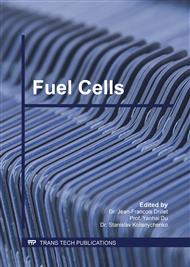[1]
B. Singh, S. Ghosh, S. Aich, B. Roy, Low temperature solid oxide electrolytes (LT-SOE): A review, J. Power Sources 339 (2017) 103.
DOI: 10.1016/j.jpowsour.2016.11.019
Google Scholar
[2]
Z. Gao, L. V. Mogni, E. C. Miller, J. G. Railsback, S. A. Barnett, A perspective on low-temperature solid oxide fuel cells, Energ. Environ. Sci. 9 (2016) 1602.
DOI: 10.1039/c5ee03858h
Google Scholar
[3]
E. D. Wachsman, K. T. Lee, Lowering the temperature of solid oxide fuel cells, Science 334 (2011) 935.
DOI: 10.1126/science.1204090
Google Scholar
[4]
L. Malavasi, C. A. Fisher, M. S. Islam, Oxide-ion and proton conducting electrolyte materials for clean energy applications: structural and mechanistic features, Chem. Soc. Rev. 39 (2010) 4370.
DOI: 10.1039/b915141a
Google Scholar
[5]
A. N. Kovalchuk, A. M. Lebedinskiy, A. A. Solovyev, I. V. Ionov, E. A. Smolyanskiy, A. V. Shipilova, A. L. Lauk, M. R. Rombaeva, Performance Characteristics of Solid Oxide Fuel Cells with YSZ/CGO Electrolyte, Key Eng. Mater. 743 (2017) 281.
DOI: 10.4028/www.scientific.net/kem.743.281
Google Scholar
[6]
T. Inoue, T. Setoguchi, K. Eguchi, H. Arai, Study of a solid oxide fuel cell with a ceria-based solid electrolyte, Solid State Ionics 35 (1989) 285.
DOI: 10.1016/0167-2738(89)90310-x
Google Scholar
[7]
W. Liu, S. W. Lee, D. Lin, F. Shi, S. Wang, A. D. Sendek, Y. Cui, Enhancing ionic conductivity in composite polymer electrolytes with well-aligned ceramic nanowires, Nat. Energy 2 (2017) 17035.
DOI: 10.1038/nenergy.2017.35
Google Scholar
[8]
Y. Chen, Y. Bu, Y. Zhang, R. Yan, D. Ding, B. Zhao, S. Yoo, D. Dang, R. Hu, C. Yang, M. Liu, A Highly Efficient and Robust Nanofiber Cathode for Solid Oxide Fuel Cells, Adv. Energy Mater. 7 (2017) 1601890.
DOI: 10.1002/aenm.201601890
Google Scholar
[9]
A. Miyamoto, S. Lee, N. F. Cooray, S. Lee, M. Mori, N. Matsuhisa, H. Jin, L. Yoda, T. Yokota, A. Itoh, M. Sekino, H. Kawasaki, T. Ebihara, M. Amagai, T. Someya, Inflammation-free, gas-permeable, lightweight, stretchable on-skin electronics with nanomeshes, Nat. Nanotechnol. 12 (2017).
DOI: 10.1038/nnano.2017.125
Google Scholar
[10]
J. Garcia-Barriocanal, A. Rivera-Calzada, M. Varela, Z. Sefrioui, E. Iborra, C. Leon, S. J. Pennycook, J. Santamaria, Colossal ionic conductivity at interfaces of epitaxial ZrO2: Y2O3/SrTiO3 heterostructures, Science 321 (2008) 676.
DOI: 10.1126/science.1156393
Google Scholar
[11]
M. G. Bellino, D. G. Lamas, N. E. Walsöe de Reca, Enhanced Ionic Conductivity in Nanostructured, Heavily Doped Ceria Ceramics, Adv. Funct. Mater. 16 (2006) 107.
DOI: 10.1002/adfm.200500186
Google Scholar
[12]
M. Zhi, S. Lee, N. Miller, N. H. Menzler, N. Wu, An intermediate-temperature solid oxide fuel cell with electrospun nanofiber cathode, Energ. Environ. Sci. 5 (2012) 7066.
DOI: 10.1039/c2ee02619h
Google Scholar
[13]
W. Liu, W. Pan, J. Luo, A. Godfrey, G. Ou, H. Wu, W. Zhang, Suppressed phase transition and giant ionic conductivity in La2Mo2O9 nanowires, Nat. Commun. 6 (2015) 8354.
DOI: 10.1038/ncomms9354
Google Scholar
[14]
A. Rothschild, Y. Komem, The effect of grain size on the sensitivity of nanocrystalline metal-oxide gas sensors, J. Appl. Phys. 95 (2004) 6374.
DOI: 10.1063/1.1728314
Google Scholar
[15]
L. Yao, W. Liu, G. Ou, H. Nishijima, W. Pan, Phase stability and high conductivity of ScSZ nanofibers: effect of the crystallite size, J. Mater. Chem. A 3 (2015) 10795.
DOI: 10.1039/c4ta06712f
Google Scholar
[16]
J. Maier, Nano-sized mixed conductors (Aspects of nano-ionics. Part III), Solid State Ionics 148 (2002) 367.
DOI: 10.1016/s0167-2738(02)00075-9
Google Scholar
[17]
I. Kosacki, T. Suzuki, V. Petrovsky, H. U. Anderson, Electrical conductivity of nanocrystalline ceria and zirconia thin films, Solid State Ionics 136-137 (2000) 1225.
DOI: 10.1016/s0167-2738(00)00591-9
Google Scholar
[18]
H. L. Tuller, Ionic conduction in nanocrystalline materials, Solid State Ionics 131 (2000) 143.
DOI: 10.1016/s0167-2738(00)00629-9
Google Scholar



